|
||
      |
Features ::
Organ transplant
The University pulls out all the stops to rebuild Rockefeller Memorial Chapel’s landmark E. M. Skinner organ.
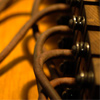
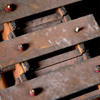
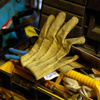

APOLOGIZING FOR HIS T-SHIRTED INFORMALITY, Rockefeller Chapel organist Thomas Weisflog, SM’69, leads the way to the chancel chamber. With each step up the winding stone staircase, the temperature rises—it’s hardly an ideal day for dismantling the thousands of pipes and windchests that make up the chapel’s E. M. Skinner organ (opus 643 in the maker’s oeuvre). But disassembling is the first step in an 18-month renovation that will leave the organ bigger—up from 7,000 pipes to 8,700—and in its best voice since its 1928 installation. At the same time, Weisflog admits, it won’t be the organ that Skinner—an American builder known for his craftsmanship, technological innovation, and romantic, symphonic sound—first envisioned.
It never was. Although the original $74,500 contract called for the construction of a single organ, the University asked for an add-on, a smaller choir organ in the chapel’s rear gallery, and Skinner found the funds by dropping a few stops from the chancel organ. Other changes came in the 1970s. Reflecting prevailing musical tastes, the romantic pipes in the English Choir division were removed and sold. New pipes were added to make the organ more suitable for baroque music. But the new tones, or voices, didn’t blend with the rest of the instrument, and by the mid-1990s, 75 percent of the sold pipes had been found and repurchased for eventual reinstallation. Meanwhile, the Skinner masterpiece, one of only four of its kind, continued to age, but not gracefully. By January 2001 it had become so unreliable—dead notes, pipes stuck in the open position, and loud air leaks wreaked havoc with the organist’s intentions—that it was completely shut down, replaced by a rented Rodger’s 957 electronic organ (still in place, it will continue to provide Rockefeller’s music during the renovation).
Piecemeal repairs would no longer suffice, but a $2.2 million restoration tab remained beyond reach until December 2005, when trustees and friends gave outgoing president Don M. Randel a $1.6 million birthday gift, earmarked for the organ’s repair.
Which is why Weisflog is climbing the limestone stairs to the organ chamber on a steamy Wednesday in July. In a process estimated to take two weeks—and fill four trucks—a crew from the Schantz Organ Company disassembles, color codes, and packs up “every piece that’s sound-producing” for the trip east to the Schantz factory in Orrville, Ohio. Despite the heat, the stairs, and the size of the job, the team is on target with three days to go. In business since 1873, Schantz installs 300 organs a year, but its experience with Skinners—the firm restored the E. M. Skinner organ in Cleveland’s Severance Hall, among others—made it Chicago’s choice.
Back in Orville, the computer-generated restoration plan includes moving the chancel organ slightly forward in its chamber so the sound doesn’t get lost in the chapel and adding some sound-brightening pipes. Weisflog rattles off the planned improvements: new choir ranks in both organs, several mixture stops, a pedal open diapason, and an en chamade or horizontal state trumpet to lend pomp and pageantry to academic convocations.
While the Skinner gets rebuilt, workmen will move into Rockefeller, fixing leaks that damaged some of the wooden pipes; updating electrical systems; and painting the chancel chamber walls a bright, light-reflecting white. In fall 2007 another Schantz crew will return to the chapel, and installation and sound checks will begin. If all goes as scheduled, the refurbished Skinner will make its debut at a January 2008 concert, the first of many events planned to showcase its improved sound.
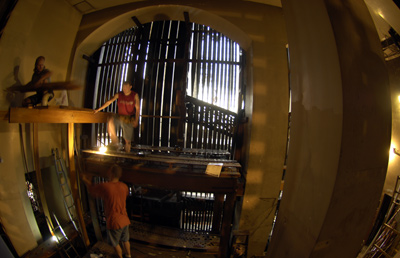
Light streams through the chancel organ’s facade as workers remove the timeworn pipes.
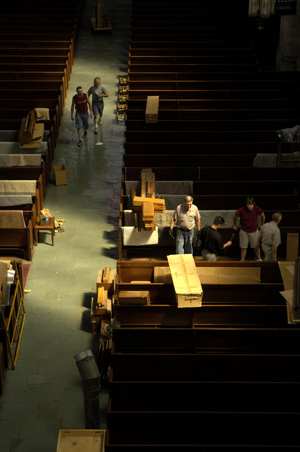
Rockefeller’s pews are pressed into duty as a staging
station
for the organ’s pipes and sound boxes.

Measure of rest: working from 7 a.m. until 5 p.m. or beyond,
the
removal crew doesn’t stray far when it’s time for a break.
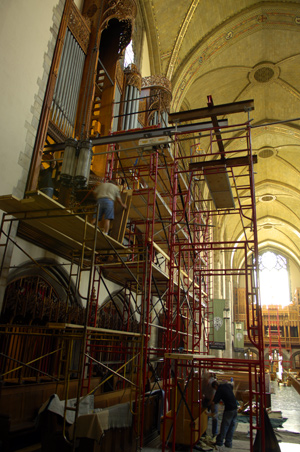
A web of scaffolding lets Schantz Organ Company foreman
Rob
Baumgartner get the chancel organ from loft to a waiting truck.